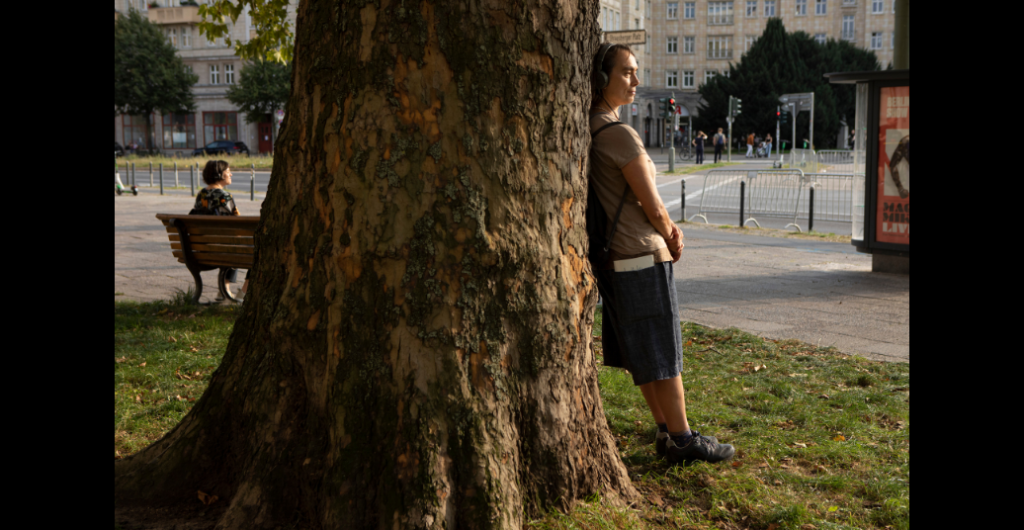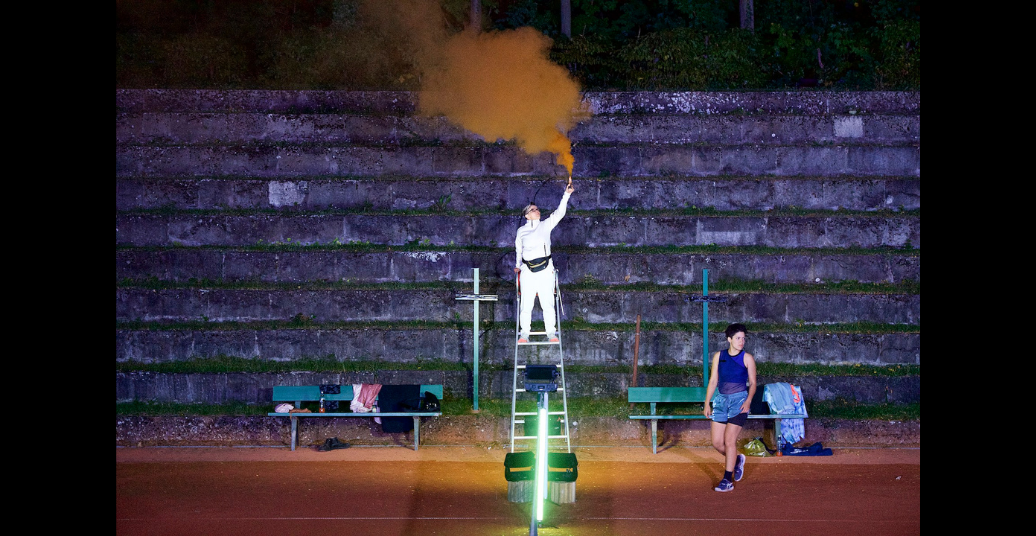As part of Tanzfabrik’s four-month fall programme for 2021, “Wilson” by Sophie Guisset and “Invitation to Walk #1 – Kreisläufe” by Katja Münker offer the audience two distinct possibilities to experience movement and choreographic composition. The first sees the audience as a voyeur, and the second sees the audience as the maker of the movement path itself.
When I arrive at Tennis-Club Tiergarten on Saturday at around 18:30 it is golden hour — that special time just before sunset — and a relaxed mood has spread all over the bar area, with the audience having drinks before the performance begins.
When I take a seat alongside one of the tennis courts, one of the performers, Isabelle Bats, is already there dressed in white, clearing the leaves from the ground and adjusting the white signs on the floor. A few moments later, a second performer enters and the lights come on. Clara Conza sits on a bench and dresses for the tennis match. While stretching, the third dancer, Lisa Vereertbrugghen, enters and follows the same routine of dressing and stretching.
The first set begins. Surprisingly, the players do not lift their rackets, but rather play only with the rest of their bodies, their gaze, and their gestures. The performers hold a vertical axis, with pauses in a squat position. The play intensifies — runs, sudden movements, slipping on the ground — and an ever-shrinking interval between each new action becomes the new movement pattern. At this climax of the match, the sound of a racket hitting the ball is played through the loudspeakers.
Bats, still in white and possibly playing the part of a referee, signals the end of the first round of play. After having a break on their benches, the tennis players move to the opposite ends of the court. In this second round, the rules of play from the first set are disrupted. The movement patterns change, the vertical axis transforms into a horizontal one, and pelvis driven rotations and movements dominate. The referee gives each player a boiled egg that they then eat slowly. After this surreal interlude, the set proceeds as a flirting sequence, where the players’ gazes meet one another intensely. Vereertbrugghen climbs over the net, entering Conza’s side of the court. The referee lets off a smoke bomb, and a set of neon lights illuminate the tennis court and on the surrounding seating terraces. One performer takes off a sock and throws it away. Conza and Vereertbrugghen move excitedly, closer and then further away again from one another. Finally, all the three stop moving and look at the audience. They leave the court by climbing up onto the terraces.
“Wilson” — which I guess derives its name from the well-known tennis brand and from Margaret Wilson, the famous 1930s tennis player — plays with the rules of the gaze. Reading two of the questions posed in the programme notes: ‘How do we perform sexuality and intimacy in the open?’ and‘How can partners play together in a codified environment and nevertheless create a sense of freedom?’, I find a strong correspondence to the piece I watched. Guisset, in my opinion, developed an intelligent and witty piece, in both structure and timing, and, evidently, in fulfilling her artistic intentions. “Wilson” invites you to watch. In the moment when the three performers look back at us, the audience, I feel as though we are naked in front of each other.
*****

Picture: “Invitation to Walk #1 – Kreisläufe”, Katja Münker ©Christian Demarco
On Sunday 26 September I had the pleasure of participating in the collective walk and podcast-release “Walk#1 Kreisläufe” by Münker at Strausberger Platz.
We meet in front of the Vesuvio Restaurant where choreographer Katja Münker, together with sound designer Mattef Kuhlmey and Tanzfabrik’s artistic director Jacopo Lanteri, welcome us and give us instructions for the walk. Strausberger Platz, despite its name and gorgeous fountain, is more of a highly congested roundabout than a leafy city square where you might sit and have a coffee. In spite of this, from the very first moment of meeting the group, I find an unexpected sense of comfort — maybe due to the quietness and clarity of the instructions or the nice feeling of having a movement together in a public space. I am able to enjoy being outside without any anxiety around rushing or social distancing.
With our headphones on, we follow the voice in the podcast, and, right from the beginning, I understand that this walk is dedicated to the experience of time. The main task is to walk in circles on and around the roundabout. During the podcast I am introduced to the history of the square — its destruction during WW2, the workers’ uprisings of the 1950s, and so on. From this history, I discover that this is not a square in which to rest, but rather a place for taking action.
In this physical experience walking becomes a means for creating relationships: with the space, with history, with the ground, and with our own individuality into a collective situation. I find this performative experience significant on various levels. Starting from the outside perspective of the place where we are walking — even though the architectural surroundings stay the same, I start to notice small details that make the place feel more familiar. In this purely experiential guided process, the sounds of the podcast welcome in the urban noises from outside, and in this way the urban landscape enters in my personal viewpoint.
From a community point of view, it is as ‘we’, considered here as ‘us, the public’, who are creating a mobile architecture within a pre-established structure. We are walking in circles, we recognise each other, playing with one another with our gazes, as though we have formed a temporary walk-in-a–circle community. As a personal somatic experience, during the walk I feel how my feet meet the ground, the sunlight and air on my face, but also how the traffic lights are influencing the speed of my walk. The external elements give me tactile feedback that affects my path and the moments of rest. From an educational perspective, the challenge of being aware of the sense of time in relationship to my inner somatic feeling informs my inner bodily connections.
This almost-one hour in-circle-walking to me passes really quickly, nevertheless I must admit that I find it demanding on a physio-physical level because of the constant need to pay attention and care towards the proposed tasks. In the after-talk, accompanied with fresh Prosecco and nice chats, Münker explains how walking has been a practice in her research from some years and also points out the extent to which this increased during the pandemic period. She tells us that she was intrigued also by the condition of staying still in a square that is not a square. In my experience, I found that this opposition between stillness and the action of walking somehow increased the perception of the walking itself.
“Invitation to Walk #1 – Kreisläufe” is the first part of a four-part podcast series “Invitation to Walk”, in which Katja Münker invites people to move around Kreuzberg and Friedrichshain. All four podcasts are available free of charge under https://soundcloud.com/tanzfabrik-berlin/sets/invitation-to-walk-katja.
You can find the full autumn programme of Tanzfabrik Berlin here.
“Wilson” (Premiere 22.09.2021) – Concept, Direction: Sophie Guisset – Dramaturgy: Lisa Vereertbrugghen – Performance: Isabelle Bats, Clara Conza, Lisa Vereertbrugghen – Light: Loic Iten – Sound design: Sophie Ruston – Choreographic adviser: Fanny Brouyaux – Stage design: KRAFT Studio – Creative producer: Pauline Payen – Production: Valérie Terwei.
“Invitation to Walk #1 – Kreisläufe” (Walk & Podcast release 26.09.2021) – Concept, Speaker: Katja Münker – Soundesign: Mattef Kuhlmey.




